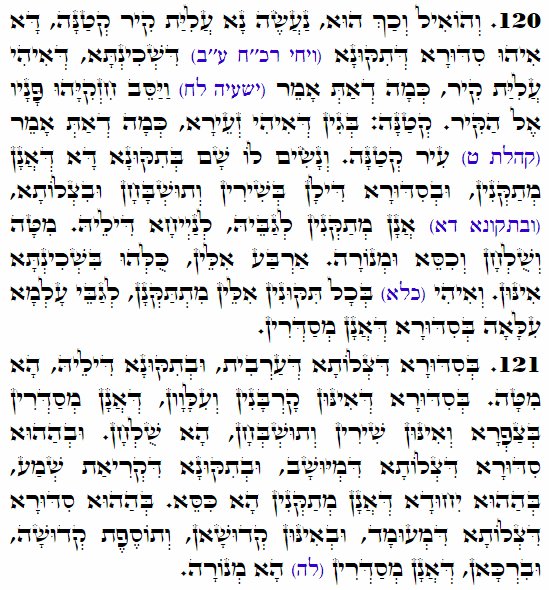Daily Zohar # 3861 – Terumah – Face the walls of your heart
Daily Zohar 3861

Hebrew translation:
121. בַּסִּדּוּר שֶׁל תְּפִלַּת עַרְבִית וּבַתִּקּוּן שֶׁלּוֹ – הֲרֵי מִטָּה. בַּסִּדּוּר שֶׁל אוֹתָם קָרְבָּנוֹת וְעוֹלוֹת שֶׁאָנוּ מְסַדְּרִים בַּבֹּקֶר וְאוֹתָם שִׁירוֹת וְתִשְׁבָּחוֹת – הֲרֵי הַשֻּׁלְחָן. וּבְאוֹתוֹ סִדּוּר שֶׁל תְּפִלַּת מְיֻשָּׁב וּבַתִּקּוּן שֶׁל קְרִיאַת שְׁמַע בְּאוֹתוֹ יִחוּד שֶׁאָנוּ מְתַקְּנִים – הֲרֵי כִּסֵּא. בְּאוֹתוֹ סִדּוּר שֶׁל תְּפִלַּת מְעֻמָּד וּבְאוֹתָן קְדֻשּׁוֹת וְתוֹסֶפֶת קְדֻשָּׁה, וּבְרָכוֹת שֶׁאָנוּ מְסַדְּרִים (לָהּ) – הֲרֵי מְנוֹרָה.
Chodesh Tov
This year is a leap year, and we have two months of Adar. Today we start the first Adar.
Zohar Terumah
Continued from previous DZ
#120
The ‘wall’ from “Let’s make a little walled upper room” (2 Kings 4:10) is the process of connecting to the Shechina in this world as we read in;
Isaiah 38:2
“וַיַּסֵּב חִזְקִיָּהוּ פָּנָיו אֶל הַקִּיר וַיִּתְפַּלֵּל אֶל יְהוָה.”
“Then Hezekiah turned his face toward the wall and prayed to YHVH,”
Setting up a ‘walled room” is how we make the elevation to Zeir Anpin with songs, praises, and prayer. The bed, a table, a chair, and a lamp are aspects of connections to the Shechina for the elevation to the supernal world, Zeir Anpin.
#121
The bed is the aspect of the night prayer, Arvit ערבית. The morning prayer, Shacharit שחרית, is the aspect of the table. It is arranged with the order of the sacrifices, songs, and praises. This prayer has parts recited while sitting, and with the unification of the Shema prayer, it establishes the ‘chair.’ The standing prayer, Amida, the Kedushot before the Shema, during the repetition, and the additional Kedusha after the Amida, together with the blessings have the aspect of the lampstand, Menora.
Lesson;
King Hezkiah turned to the wall before praying to have nothing separating him from the Shechina. The king’s prayers were answered. The Shechina supports and elevates our prayers from Malchut to Zeir Anpin.
When we pray, we should focus our thoughts on the prayer without distraction.
The Talmud explains the “wall” as the walls of the heart. It teaches us to pray from the lack and pain we experience in our hearts. It is the shortest way to connect to the Shechina and elevate our prayers to Zeir Anpin and higher levels to receive fulfillment. Shechina is our mother in this world, and when we come to her with our pain and sincerity, she helps us.
(Berachot 10b )
מַאי ״קִיר״? אָמַר רַבִּי שִׁמְעוֹן בֶּן לָקִישׁ: מִקִּירוֹת לִבּוֹ, שֶׁנֶּאֱמַר: ״מֵעַי מֵעַי אוֹחִילָה קִירוֹת לִבִּי וְגוֹ׳״.
The Gemara asks: What is meant by the word “wall [kir קיר]” in this context? Why did Hezekiah turn his face to a wall? Rabbi Shimon ben Lakish said: This symbolically alludes to the fact that Hezekiah prayed to God from the chambers [walls, kirot] of his heart, as it is stated elsewhere: “My anguish, my anguish, I am in pain. The walls of my heart. My heart moans within me” (Jeremiah 4:19).
{||}

 Previous: Terumah
Previous: Terumah

